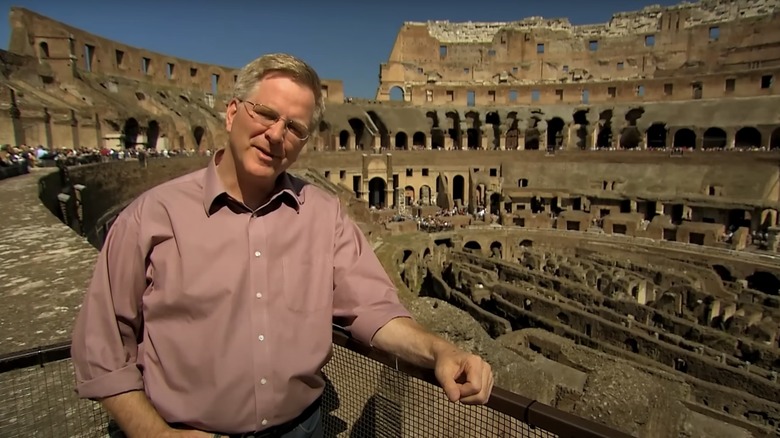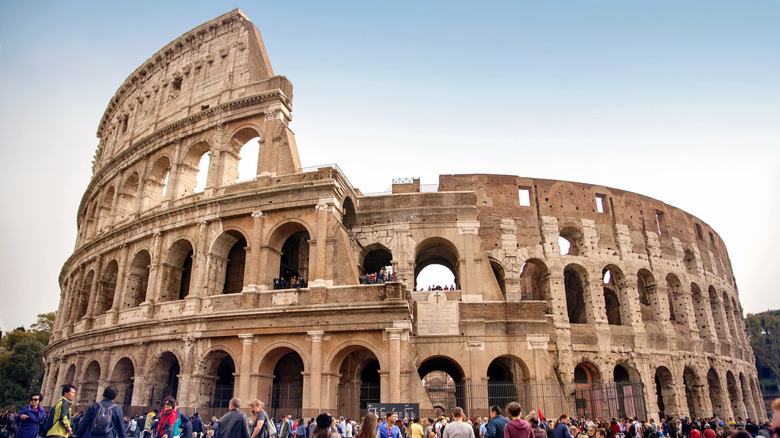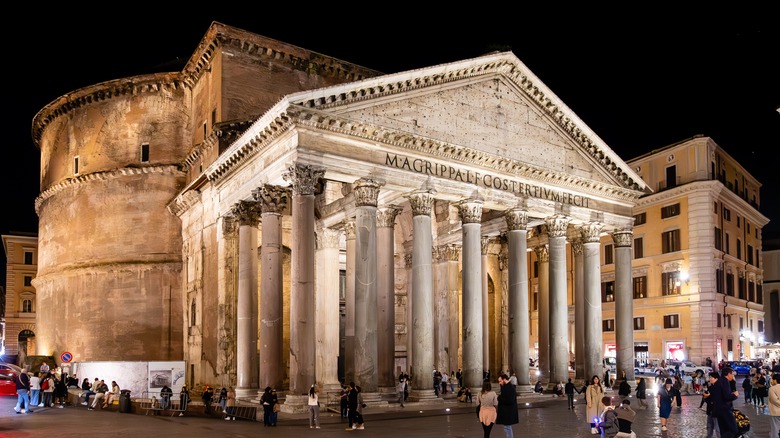Rick Steves' 'Caesar Shuffle' Tip Helps You See Three Of Rome's Most Iconic Sites Efficiently
Rome wasn't built in a day, but if you only have a day to see it, travel host Rick Steves recommends doing the Caesar Shuffle. That might sound like a thumbs-driven dance that will get you laughed out of Rome quicker than you can say "pollice verso." However, the Caesar Shuffle is just a term Steves coined for a whirlwind tour of three ancient marvels in the Eternal City: the Colosseum, the Roman Forum, and the Pantheon.
There are plenty of other famous sights you could try to knock out on a one-day Rome trip, such as the Vatican Museums, for a requisite look at the Sistine Chapel. Nonetheless, as Steves wrote on his website, "For most of us, Rome is Caesar, gladiators, chariots, and thumbs-up or thumbs-down. Ancient Rome is the one we come to see." This is the Rome you'll see as you tour the gladiatorial arena (the Colosseum), the public square where Julius Caesar was laid to rest (the Forum), and "the best-preserved temple from ancient Rome" (as Steves called the Pantheon).
St. Peter's Basilica in Vatican City was even built with stones from the Colosseum, which is directly adjacent to the Forum. Most tickets give combined entrance to the neighboring landmarks, though there are exceptions to this, like guided tours of the Colosseum at night or just its underground levels. You can also get a barrier-free ticket that covers the Forum and other sites in the Colosseum Archeological Park, but not the actual Colosseum. If you're able, though, you might as well visit both landmarks while you're there before making the 20-minute walk to the Pantheon to complete the Caesar Shuffle.
Start with the Colosseum
With a capacity of 87,000, the Colosseum is the biggest amphitheater on earth, and it has the Guinness World Record to back that up. It's also called the Flavian Amphitheater since its construction from A.D. 70 to 80 was overseen by emperors of the Flavian dynasty. Yet there was once an enormous, 103-foot statue standing outside it, the Colossus of Nero, which was almost as tall as the Statue of Liberty is from heel to head. This led to the better-known Colosseum nickname.
There's some overlap between what Rick Steves wrote about the Colosseum on his website and what he said in a 2012 episode of his show, "Rick Steves' Europe." In both cases, he observed that, in spectator sports, the Roman "taste for violence exceeded even modern America's." The modern equivalent of the Colosseum would be a football stadium, but Rome's version involved more blood sport as some (but not all) gladiators fought to the death. The Colosseum also has more architectural significance, with Steves calling it "the great example of Roman engineering."
It isn't only Greek mythology that Rome absorbed into its culture. You can see the Greek influence on structures like the Colosseum, with Steves noting on his show that it displays "all three Greek orders of columns: Doric, Ionic, and Corinthian." You might have more time to appreciate such details if you follow this trick to seeing the Colosseum with few crowds. The "Full Experience Underground and Arena" ticket lets you see the Colosseum from below and above, along with the Roman Forum and the rest of the archeological park.
Head from the Roman Forum to the Pantheon
Rick Steves called the Forum "arguably the most important piece of real estate in Western civilization." It dates to the late seventh century B.C., so it was around long before the Colosseum, though its ruins may lack the same immediate architectural grandeur. When you walk among its freestanding columns and triumphal arches, just imagine it as the nucleus of Roman life for over 1,000 years. As Steves explained on his website, it's "where the Vestal Virgins tended the perpetual fire, where Julius Caesar was cremated, and where Emperor Caligula had his palace." Military processions took place here, along with public speeches and executions (sometimes of the same individual, as in the case of the famed orator Cicero).
The Pantheon, which Steves touted as free to enter, began charging an admission fee in mid-2023. It's only 5 euros (about $5.50 at press time), and you can still access the site free on the first Sunday of every month. Once a temple, now a Catholic church, the Pantheon is likewise an architectural marvel, one that influenced the design of the Jefferson Memorial in Washington, D.C., with its commanding portico and dome.
On "Rick Steves' Europe," the host demonstrated how the portico's granite columns (Egyptian imports) are large enough that you'd need a circle of four tourists just to fit your hands around them. Inside, you can stare up at the oculus, the Pantheon's one eye hole of natural light. The dome's height is the same as its diameter — 142 feet — so it's perfectly proportioned to hold a sphere. This is also Stanley Tucci's favorite non-food-related destination in Rome.


